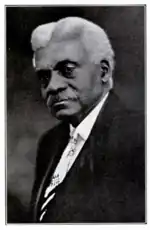George L. Knox Sr. | |
|---|---|
 | |
| Born | George L. Knox September 16, 1841 Statesville, Tennessee, US |
| Died | August 24, 1927 (aged 85) Richmond, Virginia, US |
| Occupation | Barber shop owner |
| Notable works | Slave and Freeman, the Autobiography of George L. Knox |
| Spouse |
|
| Children |
|
| Relatives |
|
George Levi Knox (1841–1927)[1] from Indianapolis Indiana, was born in Statesville, Tennessee to slave parents. He was a runaway slave who served both the South and the North in the American Civil War. Later in life he published The Indianapolis Freeman from 1893 to 1926. He was an activist and a book author.[2] Knox also owned a Negro league baseball team, Indianapolis's Barber B.B.C.[3] His grandson, George L. Knox II, was a pilot with the Tuskegee Airman during World War II.[4]
Early life
Knox was born in Statesville, Tennessee in 1841 and sold into slavery in 1844, at three years old.[5] He married Auralia Susie Knox and together they had four children.[5] During the Civil War his master took him to the front lines. Knox escaped and joined the Union where he accompanied the 55th Indiana Infantry Regiment.
After the war, Knox learned the barber business. He was successful and in 1884 he opened his own barber and shaving parlor business at a cost of $10,000 (~$325,704 in 2022).[6]
Knox's first wife Auralia died in 1910.[7] In 1914, he married a woman named Mrs. Margaret Nickens.[1]
Military
As a slave, Knox was taken by his master to the front lines to serve the Confederate States of America. He was able to escape and was welcomed by the Northern Union troops. He served with 55th Indiana Infantry Regiment as a teamster. Eventually he made his way to Indianapolis with the 55th and left the military service.[5][6]
Career
In 1884 Knox moved to Indianapolis and opened several barbershops and shaving parlors. The barbershops employed black barbers but only served white people.[8] He met many influential white people through his whites only barber shops, and he had an unsuccessful run for US Congress.[6]
In the early 1900s Knox ran shaving parlors in Indianapolis.[9] He owned an amateur Negro baseball team which was called Indianapolis's Barber Base Ball Club (B.B.C.). His son Elwood pitched for the team.[3]
Knox purchased The Indianapolis Freeman, an African-American newspaper (or race paper), and was the publisher from 1893 to 1926. The paper was called "A National Illustrated Colored Newspaper". Booker T. Washington was a contributor. The paper had a circulation of 25,000.[10] It was also sold internationally and covered everything from small black communities to sports and entertainment. The paper came out on Sundays and it was said their negative review of could ruin a career.[11]
Knox authored Slave and Freeman, the Autobiography of George L. Knox.[1]
Death
Knox died on August 24, 1927, in Richmond, Virginia from a paralytic stroke.
See also
References
- 1 2 3 Knox, George (1979). Slave and Freeman, the Autobiography of George L. Knox. Lexington Kentucky: University Press of Kentucky. pp. 43–44. ISBN 0-8131-1384-9. Retrieved 25 September 2021.
- ↑ "George Knox, Indianapolis Publisher Dies In Virginia". The Indianapolis Star. 26 August 1927. Retrieved 25 September 2021.
- 1 2 Brunson III, James E. (2019). Black Baseball 1858-1900. Jefferson, North Carolina: James E. Brunson III. p. 897. ISBN 978-0-7864-9417-0. Retrieved 26 September 2021.
- ↑ Hunter, Al. "The Ghost of Old George Knox". The Weekly View. Weekly View. Retrieved 23 September 2021.
- 1 2 3 "Colored Man, Old Friend of Riley, Dies in South". The Indianapolis News. 25 August 1927. Retrieved 25 September 2021.
- 1 2 3 George W., Penniman. "Era of progress and promise, 1863-1910: the religious, moral, and educational development of the American Negro since his emancipation". digital.ncdcr.gov. General Collection. State Library of North Carolina. Retrieved 26 September 2021.
- ↑ "Hamptons attend Mrs. George Knox funeral". The Daily Reporter. No. P1. 15 September 1910. Retrieved 26 September 2021.
- ↑ Thornbrough, Emma Lou (2 June 1980). Civil War History. Vol. 26. Gettysburg, Pennsylvania: The Kent State University Press. pp. 185–186. Retrieved 26 September 2021.
- ↑ "The finest in the State - The New Shaving Parlors". No. Advertisement. The Hancock Democrat. 3 September 1903. Retrieved 26 September 2021.
- ↑ Ad Sense. New York: The New York Magazine. 1905. p. 96. Retrieved 26 September 2021.
- ↑ Watkins, Clifford (2003). Showman. Jackson, Mississippi: University Press of Mississippi. pp. 17–18. ISBN 1-57806-555-0. Retrieved 26 September 2021.